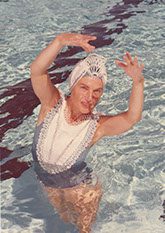
Beulah Gundling (USA)
Honor Synchronized / Artistic Swimmer (1965)
FOR THE RECORD: Premier aquatic artist; CANADIAN SYNCHRONIZED SWIMMING CHAMPIONSHIPS: gold (1949); U.S. NATIONAL AAU SYNCHRONIZED SWIMMING CHAMPIONSHIPS: 4 (outdoor), 1 tie (indoor); PAN AMERICAN GAMES: 1955 gold (solo synchronized swimming); Introduced solo synchronized swimming on an exhibition basis at the 1951 Pan American Games and the 1952 Olympic Games; Instrumental in organization of the International Academy of Aquatic Art; Author and lecturer world-wide on water ballet and synchronized swimming.
The first aquatic art (water ballet) swimmer to earn honors in the Swimming Hall of Fame is Beulah Gundling. Mrs. Gundling was the U.S.A.’s first outdoor synchronized solo champion in 1950 and she remained undefeated in national and international competition until retirement five years later from the AAU. Her strong point in these competitions was her dance composition in which she spent countless hours designing her own costumes and arranging her own music. She has since devoted her time to the International Academy of Aquatic Art, the ballet of water activity, more an expressive art form than a sports skill.
Synchronized swimming is a comparatively recent sport as the date of Mrs. Gundling’s first championship indicates. As the name implies, it is swimming synchronized with music. It was developed in North American with Canada holding the first solo championships, and the U.S. confining its activities to team and duet until 1950. Beulah Gundling won the Canadian solo crown in 1949 before beginning her five year reign in four outdoor U.S. nationals AAU championships and one tie indoors.

The traditions of synchronized swimming go a long way back to acrobatic swimming stunts performed by the likes of Benjamin Franklin on the Thames in the 18th century, up through ornamental swimming and on in to water ballet and aquatic art. The underwater sound part of synchronized is supposed to have begun as a publicity stunt staged by Ben York with Amos Jacobs (Danny Thomas) singing “Minnie, the Mermaid” from a diving helmet under water at Detroit’s Eastwood Gardens. Water shows by Alexander Ott and Billy Rose had aquatic chorus lines in the thirties.
In recognizing Mrs. Gundling as a great aquatic artist in its “miscellaneous” category, the Hall of Fame nominations committee and board of directors acknowledge her world-wide efforts to introduce more people to better swimming. Mrs. Gundling retired from competition after winning the Pan American Games gold medal in solo synchronized swimming at Mexico City in 1955. She had the honor of introducing solo synchronized swimming on an exhibition basis at the 1951 Pan American Games and at the 1952 Olympics in Helsinki, Finland.
Whether defined as a water gymnastics sport or as an aquatic art dance form, there can be no doubt as to the rapid growth of water ballet and to its influences in bringing hundreds of thousands in to swimming. Beulah Gundling has been a leading missionary with her books, film loops, and in-person demonstrations and lectures in France, Germany, Bermuda, Argentina, Israel, England, Wales, Italy, Mexico, Australia and Scandinavia.
After retirement from competitive synchronized swimming, Mrs. Gundling continued to devote most of her waking hours to water ballet, organizing with her husband and others, the International Academy of Aquatic Art–a world wide organization devoted to promoting swimming as an art form. In the ten years since 1955, she has performed with Class I honors in each of the Academy’s annual festivals. A superbly conditioned athlete who has trained herself in dance and music as well as daily swim workouts, Mrs. Gundling, just as so many of the others honored here today, is proof that aquatic athletic achievement and physical fitness need not be confined to teenagers.
